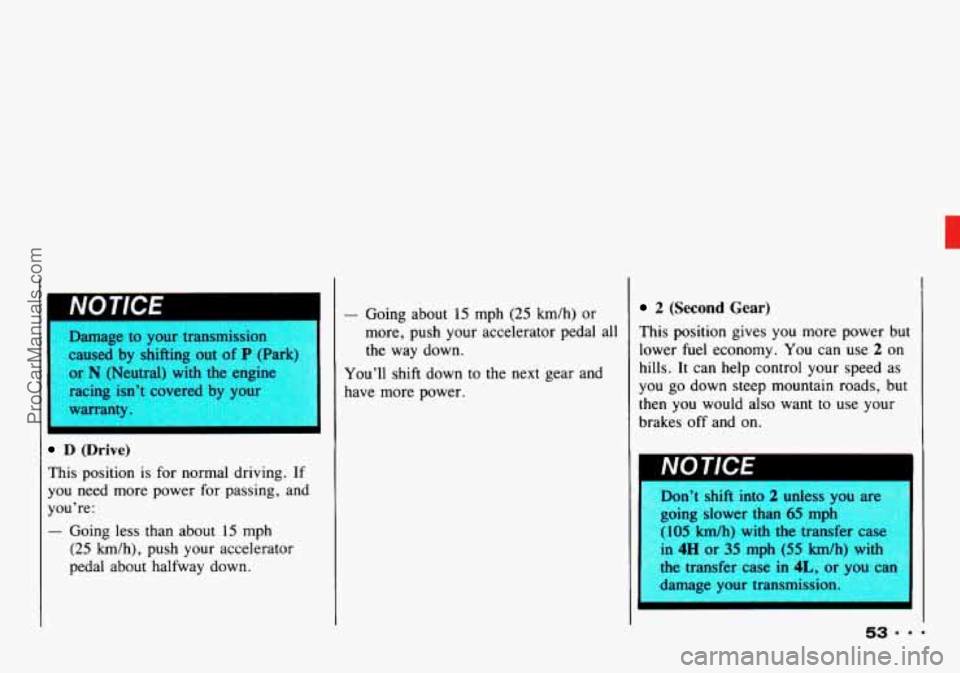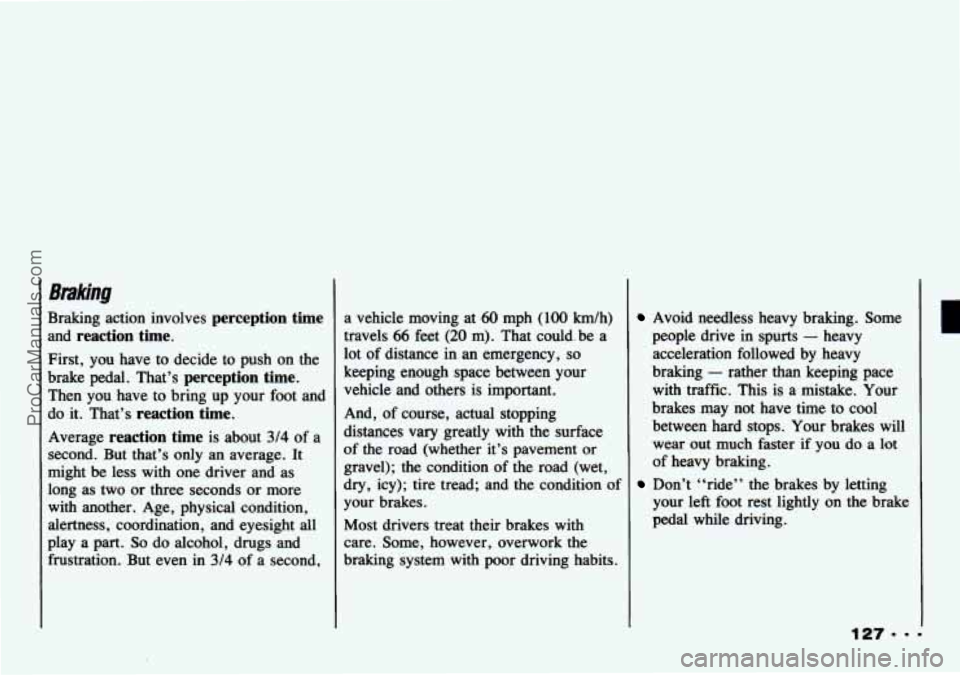1993 CHEVROLET TRACKER brakes
[x] Cancel search: brakesPage 53 of 339

r
Automatic Transmission
There are several different positions for
your shift lever.
P (Park)
This locks your rear wheels. It’s the
best position to use when you start your
engine because your vehicle can’t move
easily.
GAU I IUN I
It can be dangerous to get out
of your vehicle if the shift
lever is not
fully in P (Park) with
the parking brake firmly set. Your
vehicle could roll.
Don’t leave your vehicle when the
engine is running unless you have
to. If you have ieft the engine
running, the vehicle can move
suddenly. You or others could be
injured. To be sure your vehicle
won’t move, when you’re on fairly
level ground, always set your
parking brake and move the shift
lever
to P (Park).
If you have four-wheel drive, your
vehicle will be free to roll
- even
if your shift lever is in P (Park) - I
if your transfer case is in
N (Neutral). So, be sure the
transfer case is
in a drive gear -
not in N (Neutral).
See “Shifting into
P (Park)’’ in
the Index.
If you are parking on a
hill, or,
if you’re pulling a trailer,
also see “Parking
on Hills” or
“Towing a Trailer’’ in the Index.
I P (Park) range before starti& the
engine. Your Geo has a
brake-transmission shift interlock.
You
have to fully apply your regular brakes
before you can shift from P (Park)
when the ignition is in
the ON position.
If you cannot shift out of P (Park), ease
pressure on the shift lever
- push the
shift lever all the way into
P (Park) and
also release the shift lever button on
floor shift console models
- as you
maintain brake application. Then move
the shift lever into the gear you wish.
(Press the shift lever button before
moving the shift lever on floor shift
models.) See “Shifting Out of
P (Park)’’ in the Index.
51 ..=
ProCarManuals.com
Page 55 of 339

Damage to your transmission
caused by shifting out
of P Park)
or N (Neutral) with the engi
racing isn’t covered by your
warranty.
D (Drive)
This position is for normal driving. If
you need more power for passing, and
you’re:
- Going less than about 15 mph
(25 km/h), push your accelerator
pedal about halfway down.
- Going about 15 mph (25 h/h) or
more, push your accelerator pedal all
the way down.
You’ll shift down to
the next gear and
have more power.
2 (Second Gear)
This position gives you more power but
lower fuel economy. You can
use 2 on
hills.
It can help control your speed as
you go down steep mountain roads, but
then
you would also want to use your
brakes
off and on.
going slower than
65 mph
(105 km/h) with the transfer
in 4H or 35 mph (55 h/h) wit1
the transfer case
in 4L, or you can
damage
your transmission
53.m.
ProCarManuals.com
Page 59 of 339

Four-wheel Drive
CAUTION I
It can be dangerous to get out
4 b of your vehicle if the shift
rcyer is not fdly in P (Park)
(automatic transmission) or
R (Reverse) (manual transmission)
with the parking brake firmly set.
If you have four-wheel drive, also
be sure the transfer case is in a
drive gear. Your vehicle can roll.
If you have left the engine
running,
the vehicle can move
suddenly.
You or others could be
injured. To be sure your vehicle
won’t move, follow the step
below. If you are parking on a
hill’, or if you’re pulling a trailer,
see “Parking on Hills” cw
“Towing a Trailer” in the Index.
[f your vehicle has four-wheel drive,
you can send your engine’s driving
power to all four wheels for extra
traction.
To shift out of two-wheel drive
and into four-wheel drive, lock the
free-wheeling hubs and move
the
transfer case shift lever to 4H or 4L
(see the following). You should use 2H
for most normal driving.
Rear wheel anti-lock brakes
do not work
when you shift into four-wheel drive.
Your regular brakes will still work.
When
you shift back into two-wheel
drive, your rear wheel anti-lock brakes
will take over again. Driving
in 4H or 4L positions for
a long time on dry or wet
pavement could shorten
thP 1 nf
your vehicle’s drivetrain.
ProCarManuals.com
Page 63 of 339

To release the parking brake: Hold the
brake pedal down. Pull the parking
brake lever up
until you can push in the
release button. Hold the release button
in as you move the brake lever all the
way down.
I NOTICE
Driving with the parking brake on
can cause your rear brakes to
overheat.
You may have to replac=
them, and
you could also dvwe
other parts
of your vehicle.
If you are on a hill: See “Parking on
Hills” in
the Index. That section shows
how to turn your front wheels.
If you are towing a trailer and are
parking on any hill:
See “Towing a
Trailer”
in the Index. That section
shows what to
do first to keep the trailer
from moving.
Shifiing into P (Park)
(AUTOMATIC TRANSMlSS/ON)
It can be dangerous to get out
of your vehicle if
the shift
lever is not fully in
P (Park) with
the parking brake firmly set. Your
vehicle can roll,
If you have left the engine
running, the vehicle can move
suddenly. You or others could be
injured. To be sure your vehicle
won’t move, when you’re on fairly
level ground, use the steps that
follow.
If you have four-wheel drive and
your transfer case
is in
N (Neutral), your vehicle will be
free
to roll even if your shift lever
is in
P (Park). So, be sure the
transfer case
is in a drive gear -
not in N (Neutral).
If
you are parking on a hill, or if
you’re pulling a trailer, also see
‘‘Parking on Hills”
or ‘‘Towing a
Trailer” in the Index.
ProCarManuals.com
Page 86 of 339

Features & Controls
. . .a4
Brake System Warning Light
Your Geo’s hydraulic brake system is
divided into two parts.
If one part isn’t
working, the other part can still work
and stop you.
For good braking, though,
you need both parts working well.
Your vehicle also has rear wheel
anti-lock brakes. If the warning light
goes on, there could be a brake problem
with either your regular or rear wheel
anti-lock brakes,
or both. Have your
brake system inspected right away.
This light should come
on as you start
the vehicle. If it doesn’t come on then,
have
it fixed so it will be ready to warn
you if there’s a problem. This light will
also come on when you
set your parking brake, and it
will stay
on if your parking brake doesn’t release
fully. If it stays on after your parking
brake is fully released, it means you
may have a brake problem.
If the light comes on while driving, pull
off the road and stop carefully. You
may notice that the pedal is harder to
push.
Or, the pedal may go closer to the
floor. It may take longer to stop. If the
light is still on, have the vehicle towed
for service. (See “Towing
Your
Vehicle” in the Index.)
$ Your brake system may not
be working properly if the
brake warning light
is on. Driving
with the brake warning light on
can lead to an accident.
If the light
is still on after you’ve pulled off
the road and stopped carefully,
have the vehicle towed for service.
I
ProCarManuals.com
Page 128 of 339

Your Driving and the Road
- 9 126
There's something else about drinking
and driving that many people don't
know. Medical research shows that
alcohol in a person's system can make
crash injuries worse. That's especially
true for brain, spinal cord and heart
injuries. That means that if anyone who
has
been drinking - driver or passenger
- is in a crash, the chance of being
killed or permanently disabled is higher
than if that person had not been
drinking. And we've already seen that
the chance
of a crash itself is higher for
drinking drivers.
A
Drinking and then driving is
very dangerous. Your
reflexes, perceptions, and
I
judgment will be affected by even
a small amount of alcohol. You
could have a serious
- or even
fatal
- accident if you drive after
drinking. Please don't drink and
drive or ride with a driver who has
been drinking. Ride home in a
cab; or if you're with a group,
designate a driver who
will not
drink.
I Conboi of a Vehicle
You have three systems that make your
vehicle go where
you want it to go.
They are
the brakes, the steering and the
accelerator.
All three systems have to do
their work at the places where the tires
meet the road.
Sometimes, as when you're driving on
snow or ice, it's easy to ask more of
those control systems than the tires and
road can provide. That means you can
lose control of your vehicle.
ProCarManuals.com
Page 129 of 339

Braking
Braking action involves perception time
and reaction time.
First, you have to decide to push on the
brake pedal. That’s
perception time.
Then you have to bring up your foot and
do it. That’s
reaction time.
Average reaction time is about 3/4 of a
second. But that’s only an average.
It
might be less with one driver and as
long as two or three seconds
or more
with another. Age, physical condition,
alertness, coordination, and eyesight all
play a part.
So do alcohol, drugs and
frustration. But even in
3/4 of a second, a
vehicle moving at
60 mph (100 km/h)
travels
66 feet (20 m). That could. be a
lot of distance in an emergency,
so
keeping enough space between your
vehicle and others is important.
And, of course, actual stopping
distances vary greatly with the surface
of the road (whether it’s pavement or
gravel); the condition of the road (wet,
dry, icy); tire tread; and the condition of
your brakes.
Most drivers treat their brakes with
care. Some, however, overwork the
braking system with poor driving habits.
Avoid needless heavy braking. Some
people drive in spurts
- heavy
acceleration followed by heavy
braking
- rather than keeping pace
with traffic. This is a mistake. Your
brakes
may not have time to cool
between hard stops. Your brakes will
wear out much faster
if you do a lot
of heavy braking.
your left foot rest lightly on the brake
pedal
while driving.
Don’t “ride” the brakes by letting
ProCarManuals.com
Page 130 of 339

Your Driving
GAU I IUN
... 128
A
“Riding” your brakes can
cause them to overheat to the
I
point that they won’t work well.
You might not be able to stop your
vehicle in time
to avoid an
accident. If you “ride” your
brakes, they will get
so hot they
will require a lot of pedal force
to
slow you down. Avoid “riding”
the brakes.
NU 1 /Ut
“Riding” the brakes wears them
)ut much faster. You would n
:ostly brake replacement mucl
iooner than normal, and it
-educes
fuel econo----
If you keep pace with the traffic and
allow realistic following distances, you
will eliminate a lot
of unnecessary
braking. That means better braking and
longer brake life.
If your engine ever stops while you’re
driving, brake normally but don’t
pump your brakes. If you do, the
pedal may get harder
to push down. If
your engine stops, you will still have
some power brake assist. But you will
use
it as you brake. Once the power
assist
is used up, it may take longer to
stop and the brake pedal will be
harder
to push.
ProCarManuals.com